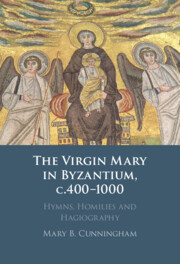
-
The digital format of this book is no longer available to purchase from Cambridge Core. Other formats may be available.
-
Select format
-
- Publisher:
- Cambridge University Press
- Publication date:
- Invalid date
- November 2021
- ISBN:
- Dimensions:
- Weight & Pages:
- Dimensions:
- Weight & Pages:
- Subjects:
- Area Studies, History, European Studies, European History 450-1000
You may already have access via personal or institutional login- Subjects:
- Area Studies, History, European Studies, European History 450-1000
Book description
The Virgin Mary assumed a position of central importance in Byzantium. This book examines her portrayal in liturgical texts during the first six centuries of Byzantine history. Focusing on three main literary genres that celebrated this holy figure, it highlights the ways in which writers adapted their messages for different audiences. Mary is portrayed variously as defender of the imperial city, Constantinople, virginal Mother of God, and ascetic disciple of Christ. Preachers, hymnographers, and hagiographers used rhetoric to enhance Mary's powerful status in Eastern Christian society, depicting her as virgin and mother, warrior and ascetic, human and semi-divine being. Their paradoxical statements were based on the fundamental mystery that Mary embodied: she was the mother of Christ, the Word of God, who provided him with the human nature that he assumed in his incarnation. Dr Cunningham's authoritative study makes a major contribution to the history of Christianity.
Contents
Metrics
Altmetric attention score
Full text views
Full text views help Loading metrics...
Loading metrics...
* Views captured on Cambridge Core between #date#. This data will be updated every 24 hours.
Usage data cannot currently be displayed.
Accessibility standard: Unknown
Why this information is here
This section outlines the accessibility features of this content - including support for screen readers, full keyboard navigation and high-contrast display options. This may not be relevant for you.
Accessibility Information
Accessibility compliance for the PDF of this book is currently unknown and may be updated in the future.


